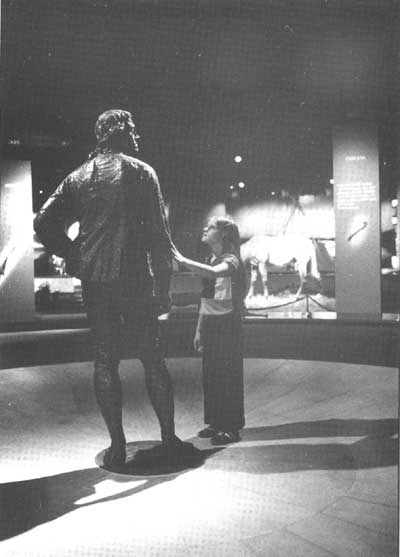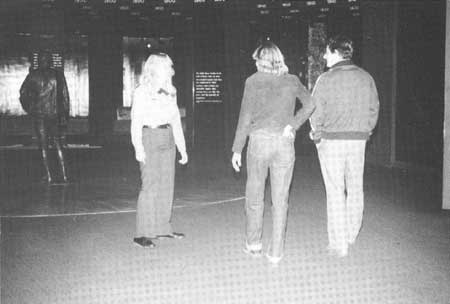|
Jefferson National Expansion
Administrative History |

|
|
Administrative History Bob Moore |

|
| A young visitor touches history in the person of a life-sized statue of Thomas Jefferson at the entrance to the Museum of Westward Expansion. Visitors were originally encouraged to touch the statue as an interpretive experience; this was later discouraged as a conservation measure. NPS photo by Joseph Matthews, April 1978. |
CHAPTER NINE:
Museum Services and Interpretation
The number and complexity of the interpretive themes at Jefferson National Expansion Memorial (JEFF) have posed a challenge to managers, historians, and interpretive rangers since the creation of the park. The Memorial is dedicated to the entire sweep of western history during the 19th century, and also focuses on life in St. Louis, the slavery issue at the Old Courthouse, as well as a rich history of its own involving the establishment of the Memorial and the building of the Gateway Arch. Throughout the years, the park staff has responded admirably to these challenges, and the result has been the development of a diverse and exciting interpretive program.
Shortly after the establishment of JEFF in 1935, proposals were made for two museums to interpret the country's westward expansion and the historic architecture of St. Louis. In the 1940s, historians at the Old Courthouse began conducting tours of the building and presenting talks on St. Louis and western history. A key component of the 1947 architectural competition was concerned with providing a means of interpreting the history of the American West, which the memorial was intended to commemorate. Eero Saarinen, in his winning design, included an outdoor arcade containing sculpture and paintings which would help tell the story of westward expansion; a campfire theater and a pioneer village for historical/interpretive purposes; and two above-ground museums. None of these aspects of the Memorial were realized due to lack of funding, but efforts to provide some sort of interpretation continued. Temporary exhibits, consisting primarily of dioramas produced by the Works Progress Administration (WPA), were opened in the Old Courthouse in the 1940s. [1]
As plans for the Memorial's development were altered and revised, it was decided to build a visitor center under the Gateway Arch which would include space for a single large museum dedicated to westward expansion. In the late 1950s, historians began working on research and exhibit plans for this underground museum, and by 1967, an interim exhibit gallery was opened in the visitor center lobby. Finally, in 1976, the long-awaited Museum of Westward Expansion was opened and became the primary interpretive feature of the park. [2]
Due to funding and support from the Jefferson National Expansion Historical Association (JNEHA), JEFF's interpretive division was supplemented by a staff of JNEHA park rangers. Dressed in brown uniforms similar in style to those of the National Park Service (NPS), this alternate "ranger corps" gradually took on a role which put JNEHA employees and NPS employees side by side, performing identical functions. In addition, JNEHA employees performed specialized duties, managing the park's audio-visual operations and the museum education program, under NPS supervision. This aspect of the interpretive division at JEFF was but one of many which made it a complex and unique operation within the NPS.
Interpretive Planning at JEFF
Interpretation at the Memorial received guidance from a variety of planning documents. The story of America's westward expansion was established as the primary interpretive theme, and with the addition of the Old Courthouse in 1940, St. Louis history and the building's involvement in the historic Dred Scott case were also emphasized. Park master plans in 1959 and 1962 identified appropriate interpretive activities, and the 1960 interpretive prospectus defined the objectives of the Memorial's projected interpretive features. In 1971, an interpretive prospectus for the Old Courthouse was completed. [3]

|
| Interpreter Lisa Hanfgarn greets visitors to the Museum of Westward Expansion, 1978. NPS photo. |
In 1981, the National Park Service mandated a new management document called the Annual Statement for Interpretation (SFI). The SFI was created to adequately address changes in individual interpretive programs, as well as record activities and accomplishments in each national park area's interpretive division. The initial Statements for Interpretation prepared at JEFF listed four specific interpretive themes: the vision of the United States as seen by Thomas Jefferson and other Americans in the early 19th century, which resulted in the territorial expansion of the U.S.; the settling of the West, made up of the daily life, experiences, and adventures of frontiersmen and pioneers who explored and populated the American West; the role of St. Louis as a base of operations and emporium for the trans-Mississippi West; and the architectural significance of the Gateway Arch and the Old Courthouse. [4] By 1987 two more sub-themes were added, which involved the history of St. Louis and the heritage of African-Americans, using the Dred Scott trials as a focus. [5]
Basic personal services described in the SFI during the 1980s included staffing the Museum of Westward Expansion through the use of both fixed stations and roving assignments; general public programs; museum education programs; staffing the visitor center information desk and the top of the Gateway Arch; orientation to and tours of the Old Courthouse; and special programs such as Storytelling and Black History Month. Among the non-personal services were publications such as the park newspaper Gateway Today, and orientation brochures for the Arch and Old Courthouse. The curatorial staff and a temporary exhibit staff were managed by the interpretive division chief as well. As the program grew, more services were added, including Victorian Christmas at the Old Courthouse; Boy and Girl Scout Days; the Union Station Urban Initiative; and the production of the informational handout, the Museum Gazette, primarily for in-house use. With the development of the Statement for Interpretation, the park gained a valuable tool for managing its interpretive program. [6]
| <<< Previous | <<< Contents >>> | Next >>> |
jeff/adhi/adhi2-9.htm
Last Updated: 15-Jan-2004